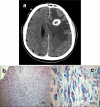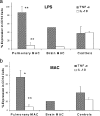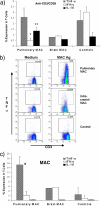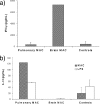Clinical and immunologic features of an atypical intracranial mycobacterium avium complex (MAC) infection compared with those of pulmonary MAC infections
- PMID: 18701648
- PMCID: PMC2565932
- DOI: 10.1128/CVI.00173-08
Clinical and immunologic features of an atypical intracranial mycobacterium avium complex (MAC) infection compared with those of pulmonary MAC infections
Abstract
Members of the Mycobacterium avium complex (MAC) may cause chronic pulmonary infections in otherwise healthy elderly persons but rarely invade parts of the body outside of the lungs in immunocompetent hosts. We present a case of an isolated intracranial MAC infection in an apparently immunocompetent individual and review previous reports. We studied the T-cell and monocyte responses in healthy volunteers, individuals with a pulmonary MAC infection, and one individual with an isolated intracranial MAC infection. Genomic DNA from the individual with the brain MAC infection was studied for gamma interferon (IFN-gamma) receptor mutations. Individuals with localized pulmonary MAC infections showed increased activation of monocytes and enhanced monocyte and T-cell tumor necrosis factor alpha (TNF-alpha) production in response to lipopolysaccharide and MAC antigens but defects in T-cell IFN-gamma secretion. The individual with an intracranial MAC infection showed a lack of monocyte activation and deficiencies in both monocyte and T-cell TNF-alpha production and monocyte interleukin-12 (IL-12) production but had preserved T-cell IFN-gamma production. Mutations or deletions in the IFN-gamma receptor were not detected in the individual with the intracranial MAC infection. Our data suggest that distinct immune defects characterize two different manifestations of MAC infection. A relative defect in IFN-gamma production in response to MAC may predispose an individual to localized but partially controlled lung disease, whereas defects leading to reduced IL-12 and TNF-alpha production may allow the dissemination of MAC. Further studies delineating the potential role of TNF-alpha in limiting the spread of MAC outside the lung are warranted.
Figures




Similar articles
-
Cytokine profiles in immunocompetent persons infected with Mycobacterium avium complex.J Infect Dis. 2001 Feb 1;183(3):478-84. doi: 10.1086/318087. Epub 2000 Dec 20. J Infect Dis. 2001. PMID: 11133380
-
Defective T cell function for inhibition of growth of Mycobacterium avium-intracellulare complex (MAC) in patients with MAC disease: restoration by cytokines.J Infect Dis. 2000 Dec;182(6):1664-71. doi: 10.1086/317601. Epub 2000 Oct 23. J Infect Dis. 2000. PMID: 11069238
-
IL-32 expression in the airway epithelial cells of patients with Mycobacterium avium complex lung disease.Int Immunol. 2011 Nov;23(11):679-91. doi: 10.1093/intimm/dxr075. Epub 2011 Oct 27. Int Immunol. 2011. PMID: 22033195 Free PMC article.
-
[Immunological studies in cases of pulmonary Mycobacterium avium complex infection without predisposing conditions].Nihon Kokyuki Gakkai Zasshi. 2004 Mar;42(3):232-8. Nihon Kokyuki Gakkai Zasshi. 2004. PMID: 15069779 Japanese.
-
Potential role of cytokines in disseminated mycobacterial infections.Eur J Clin Microbiol Infect Dis. 1994;13 Suppl 2:S29-33. doi: 10.1007/BF01973599. Eur J Clin Microbiol Infect Dis. 1994. PMID: 7875149 Review.
Cited by
-
The first US domestic report of disseminated Mycobacterium avium complex and anti-interferon-γ autoantibodies.J Clin Immunol. 2014 Nov;34(8):928-32. doi: 10.1007/s10875-014-0073-9. Epub 2014 Aug 23. J Clin Immunol. 2014. PMID: 25149293 Free PMC article.
-
BCG Vaccination Induces M. avium and M. abscessus Cross-Protective Immunity.Front Immunol. 2019 Feb 19;10:234. doi: 10.3389/fimmu.2019.00234. eCollection 2019. Front Immunol. 2019. PMID: 30837992 Free PMC article.
-
Neurological manifestations of nontuberculous mycobacteria in adults: case series and review of the literature.Front Neurol. 2024 Apr 26;15:1360128. doi: 10.3389/fneur.2024.1360128. eCollection 2024. Front Neurol. 2024. PMID: 38742044 Free PMC article.
-
Metagenomic next-generation sequencing assistance in identifying Mycobacterium avium meningoencephalitis: A case report and literature review.Heliyon. 2024 Mar 27;10(7):e28630. doi: 10.1016/j.heliyon.2024.e28630. eCollection 2024 Apr 15. Heliyon. 2024. PMID: 38596092 Free PMC article.
-
Mycobacterium avium-intracellulare otomastoiditis in a young AIDS patient: case report and review of the literature.HIV AIDS (Auckl). 2013;5:61-6. doi: 10.2147/HIV.S36545. Epub 2013 Feb 22. HIV AIDS (Auckl). 2013. PMID: 23459156 Free PMC article.
References
-
- Algood, H. M., P. L. Lin, D. Yankura, A. Jones, J. Chan, and J. L. Flynn. 2004. TNF influences chemokine expression of macrophages in vitro and that of CD11b+ cells in vivo during Mycobacterium tuberculosis infection. J. Immunol. 172:6846-6857. - PubMed
-
- Altare, F., A. Durandy, D. Lammas, J. F. Emile, S. Lamhamedi, F. Le Deist, P. Drysdale, E. Jouanguy, R. Doffinger, F. Bernaudin, O. Jeppsson, J. A. Gollob, E. Meinl, A. W. Segal, A. Fischer, D. Kumararatne, and J. L. Casanova. 1998. Impairment of mycobacterial immunity in human interleukin-12 receptor deficiency. Science 280:1432-1435. - PubMed
-
- Bean, A. G., D. R. Roach, H. Briscoe, M. P. France, H. Korner, J. D. Sedgwick, and W. J. Britton. 1999. Structural deficiencies in granuloma formation in TNF gene-targeted mice underlie the heightened susceptibility to aerosol Mycobacterium tuberculosis infection, which is not compensated for by lymphotoxin. J. Immunol. 162:3504-3511. - PubMed
-
- Boehm, U., T. Klamp, M. Groot, and J. C. Howard. 1997. Cellular responses to interferon-gamma. Annu. Rev. Immunol. 15:749-795. - PubMed
Publication types
MeSH terms
Substances
LinkOut - more resources
Full Text Sources

